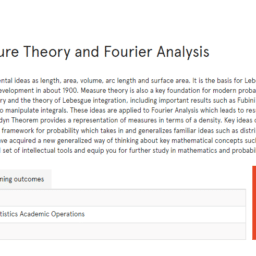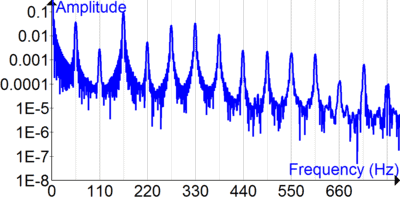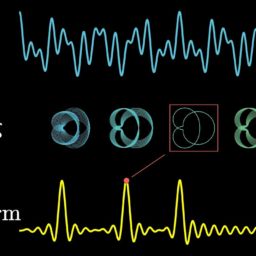MY-ASSIGNMENTEXPERT™可以为您提供sydney MATH4069 Fourier analysis傅里叶分析的代写代考和辅导服务!
这是悉尼大学 傅里叶分析课程的代写成功案例。

MATH4069课程简介
Measure theory is the study of fundamental ideas as length, area, volume, arc length and surface area. It is the basis for Lebesgue integration theory used in advanced mathematics ever since its development in about 1900. Measure theory is also a key foundation for modern probability theory. The course starts by establishing the basics of measure theory and the theory of Lebesgue integration, including important results such as Fubini’s Theorem and the Dominated Convergence Theorem which allow us to manipulate integrals. These ideas are applied to Fourier Analysis which leads to results such as the Inversion Formula and Plancherel’s Theorem. The Radon-Nikodyn Theorem provides a representation of measures in terms of a density. Key ideas of this theory are applied in detail to probability theory to provide a rigorous framework for probability which takes in and generalizes familiar ideas such as distributions and conditional expectation. When you complete this unit you will have acquired a new generalized way of thinking about key mathematical concepts such as length, area, integration and probability. This will give you a powerful set of intellectual tools and equip you for further study in mathematics and probability.
Prerequisites
At the completion of this unit, you should be able to:
- LO1. explain and apply the fundamentals of abstract measure and integration theory
- LO2. explain what an outer measure and use outer measures to construct other measures. Apply these concepts to Lesbesgue measures and other related measures.
- LO3. explain and apply the limit theorems including the dominated convergence theorem and theorems on continuity and differentiability of parameter integrals.
- LO4. explain the properties of Lp spaces
- LO5. use inequalities such as Holder’s, Minkowsi’s, Jensen’s and Young’s inequalities to solve problems
- LO6. explain and apply the properties of the Fourier series on normed spaces
- LO7. generate the measure theoretic foundations of probability theory
- LO8. recall and explain the definition and basic properties of conditional expectation
- LO9. create proofs and apply measure theory in diverse applications.
MATH4069 Fourier analysis HELP(EXAM HELP, ONLINE TUTOR)
Consider the $N$ ! functions on the line
$$
f_\sigma=\sum_{j=1}^N \frac{N}{\sigma(j)} \chi_{\left(\frac{j-1}{N}, j\right)},
$$
where $\sigma$ is a permutation of the set ${1,2, \ldots, N}$.
(a) Show that each $f_\sigma$ satisfies $\left|f_\sigma\right|_{L^{1, \infty}}=1$.
(b) Show that $\left|\sum_{\sigma \in S_N} f_\sigma\right|_{L^{1, \infty}}=N$ ! $\left(1+\frac{1}{2}+\cdots+\frac{1}{N}\right)$.
(c) Conclude that the space $L^{1, \infty}(\mathbf{R})$ is not normable.
(d) Use a similar argument to prove that $L^{1, \infty}\left(\mathbf{R}^n\right)$ is not normable by considering the functions
$$
f_\sigma\left(x_1, \ldots, x_n\right)=\sum_{j_1=1}^N \cdots \sum_{j_n=1}^N \frac{N^n}{\sigma\left(\tau\left(j_1, \ldots, j_n\right)\right)} \chi_{\left[\frac{j_1-1}{N}, \frac{j_1}{N}\right)}\left(x_1\right) \cdots \chi_{\left[\frac{j_n-1}{N}, \frac{j_n}{N}\right)}\left(x_n\right),
$$
where $\sigma$ is a permutation of the set $\left{1,2, \ldots, N^n\right}$ and $\tau$ is a fixed injective map from the set of all $n$-tuples of integers with coordinates $1 \leq j \leq N$ onto the set $\left{1,2, \ldots, N^n\right}$. One may take
$$
\tau\left(j_1, \ldots, j_n\right)=j_1+N\left(j_2-1\right)+N^2\left(j_3-1\right)+\cdots+N^{n-1}\left(j_n-1\right),
$$
for instance.
Let $0<p<1,0<s<\infty$ and let $(X, \mu)$ be a measure space.
(a) Let $f$ be a measurable function on $X$. Show that
$$
\int_{|f| \leq s}|f| d \mu \leq \frac{s^{1-p}}{1-p}|f|_{L^{p, \infty}}^p .
$$
(b) Let $f_j, 1 \leq j \leq m$, be measurable functions on $X$. Show that
$$
\left|\max {1 \leq j \leq m}\left|f_j\right|\right|{L^{p, \infty}}^p \leq \sum_{j=1}^m\left|f_j\right|_{L^{p, \infty}}^p .
$$
(c) Conclude that
$$
\left|f_1+\cdots+f_m\right|_{L^{p, \infty}}^p \leq \frac{2-p}{1-p} \sum_{j=1}^m\left|f_j\right|_{L^{p, \infty}}^p
$$
The latter estimate is referred to as the $p$-normability of weak $L^p$ for $p<1$. [Hint: Part (c): First obtain the estimate $$ d_{f_1+\cdots+f_m}(\alpha) \leq \mu\left(\left{\left|f_1+\cdots+f_m\right|>\alpha, \max \left|f_j\right| \leq \alpha\right}\right)+d_{\max \left|f_j\right|}(\alpha)
$$
for all $\alpha>0$.]
Let $0<p_0<p<p_1 \leq \infty$ and let $\frac{1}{p}=\frac{1-\theta}{p_0}+\frac{\theta}{p_1}$ for some $\theta \in[0,1]$. Prove the following:
$$
\begin{aligned}
|f|_{L^p} & \leq|f|_{L^{p_0}}^{1-\theta}|f|_{L^{p_1}}^\theta, \
|f|_{L^{p, \infty}} & \leq|f|_{L^{p_0, \infty}}^{1-\theta}|f|_{L^{p_1, \infty}}^\theta .
\end{aligned}
$$
(Loomis and Whitney [178]) Follow the steps below to prove the isoperimetric inequality. For $n \geq 2$ and $1 \leq j \leq n$ define the projection maps $\pi_j: \mathbf{R}^n \rightarrow$ $\mathbf{R}^{n-1}$ by setting for $x=\left(x_1, \ldots, x_n\right)$,
$$
\pi_j(x)=\left(x_1, \ldots, x_{j-1}, x_{j+1}, \ldots, x_n\right),
$$
with the obvious interpretations when $j=1$ or $j=n$.
(a) For maps $f_j: \mathbf{R}^{n-1} \rightarrow \mathbf{C}$ prove that
$$
\Lambda\left(f_1, \ldots, f_n\right)=\int_{\mathbf{R}^n} \prod_{j=1}^n\left|f_j \circ \pi_j\right| d x \leq \prod_{j=1}^n\left|f_j\right|_{L^{n-1}\left(\mathbf{R}^{n-1}\right)} .
$$
(b) Let $\Omega$ be a compact set with a rectifiable boundary in $\mathbf{R}^n$ where $n \geq 2$. Show that there is a constant $c_n$ independent of $\Omega$ such that
$$
|\Omega| \leq c_n|\partial \Omega|^{\frac{n}{n-1}},
$$
where the expression $|\partial \Omega|$ denotes the $(n-1)$-dimensional surface measure of the boundary of $\Omega$.
[Hint: Part (a): Use induction starting with $n=2$. Then write
$$
\begin{aligned}
\Lambda\left(f_1, \ldots, f_n\right) & \leq \int_{\mathbf{R}^{n-1}} P\left(x_1, \ldots, x_{n-1}\right)\left|f_n\left(\pi_n(x)\right)\right| d x_1 \cdots d x_{n-1} \
& \leq|P|_{L^{\frac{n-1}{n-2}}\left(\mathbf{R}^{n-1}\right)}\left|f_n \circ \pi_n\right|_{L^{n-1}\left(\mathbf{R}^{n-1}\right)},
\end{aligned}
$$
where $P\left(x_1, \ldots, x_{n-1}\right)=\int_{\mathbf{R}}\left|f_1\left(\pi_1(x)\right) \cdots f_{n-1}\left(\pi_{n-1}(x)\right)\right| d x_n$, and apply the induction hypothesis to the $n-1$ functions
$$
\left[\int_{\mathbf{R}} f_j\left(\pi_j(x)\right)^{n-1} d x_n\right]^{\frac{1}{n-2}},
$$
for $j=1, \ldots, n-1$, to obtain the required conclusion. Part (b): Specialize part (a) to the case $f_j=\chi_{\pi_j[\Omega]}$ to obtain
$$
|\Omega| \leq\left|\pi_1[\Omega]\right|^{\frac{1}{n-1}} \cdots\left|\pi_n[\Omega]\right|^{\frac{1}{n-1}}
$$
and then use that $\left|\pi_j[\Omega]\right| \leq \frac{1}{2}|\partial \Omega|$.

MY-ASSIGNMENTEXPERT™可以为您提供STANFORD EE261 FOURIER ANALYSIS傅里叶分析的代写代考和辅导服务!





